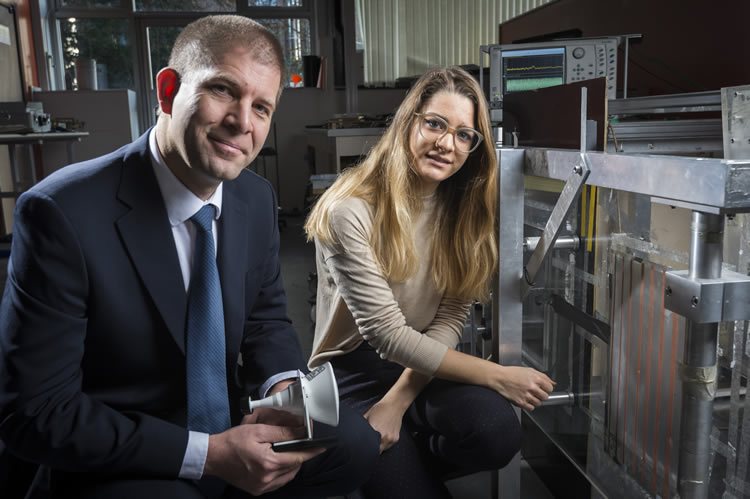
Pictured above Professor James Watts (CEO of Flann Microwave) and Julia De Pineda-Gutierrez (Centre for Doctoral Training in Metamaterials)
Microwave engineering company Flann Microwave and the Centre for Doctoral Training in Metamaterials (XM2), part of the University of Exeter’s Department of Physics and Astronomy, have teamed up on a four-year project that will investigate the use of metamaterials in antennas for point-to-point radio networks, such as mobile phone networks, potentially making antennas smaller, cheaper, more powerful and less intrusive.
Metamaterials are materials that are engineered or treated to produce properties that don’t occur naturally. They are formed by assembling multiple elements made from composite materials such as plastics or metals. Using metamaterials in metasurface antennas reduces the size of the antenna and increases the power it radiates, while also allowing it to absorb light waves. A metamaterial antenna behaves as if it were much larger than its actual size because it stores and re-radiates energy.
In order to handle increased data volumes and speeds, 5G will need significantly more microwave antennas than previous mobile networks. They will need to be relatively inexpensive to manufacture and install in order to make widespread deployment financially viable. The smaller and more lightweight they are, the cheaper and easier they will be to manufacture, ship and install.
A challenge with the higher frequencies that 5G will operate in is that radio signals don’t travel as far as in lower frequency spectrum, they are not as good at passing through obstacles like buildings, and they can’t go around corners. 5G networks will therefore need highly-directional antennas with narrow beams so that signals aren’t lost. A key focus of the project will be to develop surface structures and materials which can be used to manipulate radio waves to form narrow beams.
Now you see it…
The use of metamaterials also opens up the possibility of antennas being incorporated into everyday features and structures, so they are less visually intrusive. Some metamaterials can bend electromagnetic radiation, such as light, around an object to give the appearance that it isn’t there. Think Harry Potter’s Invisibility Cloak or the Klingons’ ship cloaking device in Star Trek, the science fiction is nearing reality!
Professor James Watts, CEO of Flann Microwave, said “This is incredibly exciting work which has implications nationally and internationally in the development of next generation communications networks. We are excited at an academic level and by the practical and commercial opportunities which we hope will flow from this project and which could one day become mainstream in network development.”
The project is the latest in a series of collaborations between Flann Microwave and the University. Their relationship has deepened since the £12 million XM2 was established in 2014 with funding from the Engineering and Physical Sciences Research Council (EPSRC), the university and industry. James Watts serves on the XM2 Oversight Board and has been an Honorary Associate Professor at the University of Exeter since November 2016.
Image: Flann





